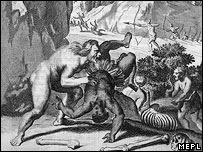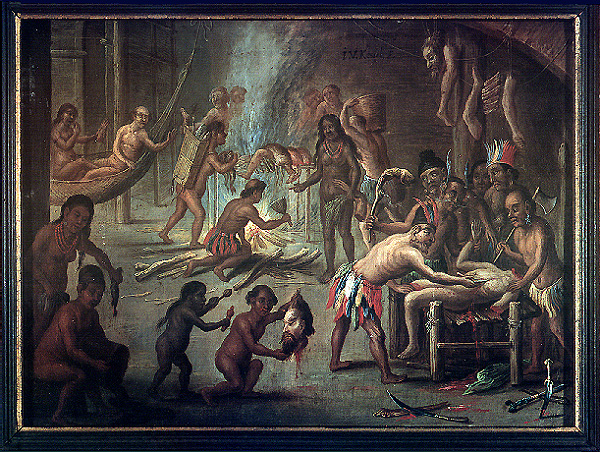





















A cannibal refers to an organism that eats the flesh of its own kind. Cannibalism, or anthropophagy, is generally prohibited in modern societies. Despite its taboo, the act of cannibalism has been practiced on men, women and children all over the world and throughout time.
Among humans cannibalism has been widespread in prehistoric societies on all continents, and is still practiced in areas of New Guinea and other remote pockets of the world. Until Western influence was responsible for it's termination, it existed among modern cultures in parts of West and Central Africa, Sumatra, Melanesia and Polynesia, with various Indian tribes of North and South America, and among the aborigines of Australia and the Maoris of New Zealand

Cannibalism: Civilized or Uncivilized? It is often the Western and European ethnocentric way to see cannibalistic societies as savage and evil, but one must consider the impetus for such an outlook. The Western taboo against cannibalism can be traced back to the first known written account, which comes to us from Christopher Columbus. The term cannibalism is derived from the name of the West Indian Carib tribe, who were called "caribal" by the Spanish explorers. The Carib tribe were alleged human eaters, although this account is questionable. Early accounts of cannibalism by European colonizers are largely overstated and inaccurate. Cannibalism was used as a justification for colonizing and subjugating the native people and their land. In the 16th century Queen Isabella of Spain decreed that Spanish colonists could only legally enslave natives who were cannibals, thus giving the colonists an interest in making these claims.
"We assume that cannibalism is always an aggressive, barbaric and degrading act. But that is a serious over-simplification, one that has kept us from realizing that cannibalism can have positive meanings and motives that are not that far from our own experience." - Beth A. Conklin who studied the Wari' tribe of the Amazon rainforest.
Cannibalism can be classified according to the affiliation of the consumed. Thus, endocannibalism refers to the consumption of individuals within a group, exocannibalism is the consumption of outsiders, and autocannibalism is self-consumption that can range anywhere from nail biting to torture-induced consumption.
In addition, cannibalism can be classified based on motivation.
Several types of cannibalism have been described in terms of their purpose:
Gastronomic cannibalism- to satisfy hunger, provide a supplement to the regular diet
Survival cannibalism- to survive under conditions of severe starvation (ex: Donner Party) Starvation is the leading cause for modern day instances of cannibalism.
Medicinal cannibalism- to cure or ward off disease
Mortuary cannibalism- to maintain continuity with one's dead relatives, as a manner of reverence for ancestors, or for a desire for the soul of the dead to be reborn in the body of the consumer.
Sacrificial cannibalism- to propitiate gods, enact revenge, or gain the strength of an enemy. In ancient Meso America, men representing the gods were often sacrificed and eaten to link the participant with the deity.
Political cannibalism- to terrify one's neighbors or enemies by publicly consuming those you capture and kill. Headhunters, for example, often consumed certain parts of a body to gain the powers of the dead person.
Pathological cannibalism- Practicing cannibalism within a culture where it's not accepted. One modern example is Fritz Haarman, the "Hanover Vampire," who in 1924 in Germany was convicted of killing at least 27 boys, making sausage out of their flesh, eating them and also selling it to unsuspecting people for human consumption.